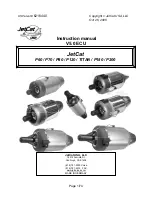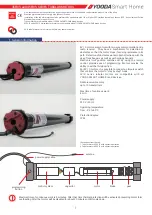
42
CHAPTER 6 ELECTRICAL SYSTEMS
GENERAL INFORMATION
The electrical system consists of three main elements: a battery, a starting circuit, and a charging circuit. The battery
is part of both the starting and charging circuit. The battery should be checked before going into any extensive starter
or charging system checks. If a battery has a shorted cell, overcharging can result, and the regulator or rectifier may
appear to be at fault. If a cell has an open or high resistance connection, the electric starter operation will be affected.
The power source used to provide the energy to turn an electric starter motor on Tecumseh engines is either 120 volt
A.C. current or 12 volt D.C. An A.C. starter circuit utilizes a 120 volt power source instead of a battery. The 12 volt
battery models require a charging system to maintain proper battery charge.
The starting circuit includes the battery, battery cables, starter or ignition switch, safety switches, and an electric
starter motor.
The charging system consists of alternator charge coils, rectifiers or diodes, regulator, ignition switch, flywheel magnets,
and a battery. All engines that have a charging system will use a combination of some or all of these features.
OPERATION
1
THRUST WASHER
END CAP
ARMATURE
SPRING
GEAR
ENGAGING NUT
NUTS
WASHER
END CAP
DUST COVER
RETAINER
SPRING
RETAINER
HOUSING
BRUSH CARD
BRUSH SPRINGS
BRUSHES
BOLT
LOCK NUT
ROTATION OF FLYWHEEL
2
STARTING CIRCUIT AND ELECTRIC
STARTERS
After all of the safety interlock switches have been
activated, the starter switch will complete the circuit. A
strong magnetic force is produced by the electrical current
running through the armature windings. The armature
magnetism repels the magnetism produced by the
permanent field magnets of the electric starter. The
repelling magnetic forces cause the armature to rotate,
moving the drive pinion laterally on the splined armature
shaft, meshing the starter pinion gear with the flywheel
ring gear. When the drive pinion contacts the stop at the
end of the armature shaft, the pinion rotates along with
the armature shaft to crank the engine. The armature and
pinion remain positively engaged until the engine fires
and the flywheel rotates faster than the armature. The
greater momentum of the flywheel throws the starter
pinion gear out of mesh and forces the starter pinion back
to the disengaged position. After the switch is released,
the starting circuit is opened and the armature coasts to
a stop. A small anti-drift spring holds the pinion in the
disengaged position (diag. 1).
CHARGING CIRCUIT
When a conductor (alternating coils) cuts the magnetic
field generated by the magnets in the flywheel, a current
will be induced in the alternator coil. The permanent
magnets in the flywheel have a magnetic field in which
the lines of magnetic force run from the North Pole to the
South Pole. As the flywheel rotates and the position of
the magnets change, the direction of the magnetic field
changes or alternates. The alternating coils are wound in
different directions to allow current to flow as an A.C.
waveform (diag. 2).
















































